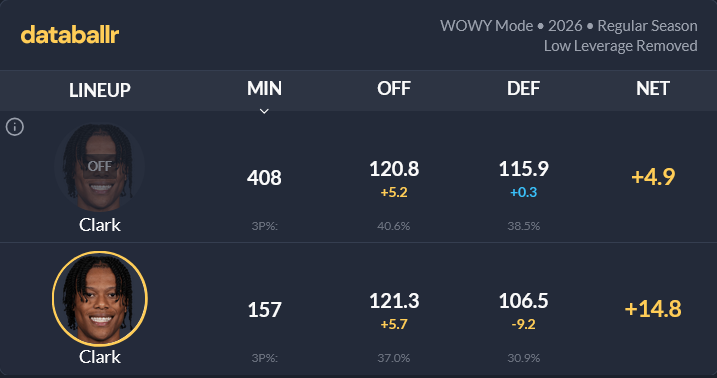In today’s cap-apron era, it’s a major success whenever a front office can find impact minutes from a second-round draft selection.
Franchises occasionally draft players like Nikola Jokic and Jalen Brunson in the second round. However, the most realistic impact outcome occurs when capped-out playoff contenders can find impact role players.
Winning teams can get a significant boost when they can add impactful depth to talented rosters in the second round. Recent examples include the Oklahoma City Thunder drafting Ajay Mitchell and Aaron Wiggins, the Indiana Pacers drafting Andrew Nembhard, and the New York Knicks drafting Deuce McBride.
For the Minnesota Timberwolves, Jaylen Clark is slowly becoming the impact second-round role player selection they desperately need off the bench.
If he hadn’t torn his Achilles tendon late in his junior season at UCLA, Clark could have potentially gone late in the first round. Even with Clark sidelined for his entire rookie year, Clark’s talent and potential as an end-of-the-bench piece were hard for Tim Connelly and Minnesota’s front office to pass up.
While at UCLA, Clark had a successful three-year career on talented teams. He was able to get by on offense by being an active cutter and by using his strength to outmatch defenders downhill. However, he thrived by being a menace at the point of attack, winning the Naismith Defensive Player of the Year in 2023.
Based on his time at UCLA, Clark’s NBA blueprint was simple. He projected well as a low-usage player on offense who would spend most of his time in the corner, while he expended all of his energy defensively.
The counting stats may not jump off the page for Clark this season. He has averaged just 5.2 points per game, 2.6 rebounds, and 1.0 steals per game in 17.2 minutes per game. However, the Timberwolves have continued to play some of their best basketball when Clark has been on the court.
When Clark is on the court, the offensive rating (ORTG) remains similar to when Clark is on the bench. However, Minnesota’s defensive rating (DRTG) jumps from 115.9 when Clark is off the court, compared to 106.5 when Clark is on the court. As a result, opponents are scoring 9.2 points per 100 possessions less when Clark is on the court versus off the court.

Clark is ultimately on the court to be a defensive specialist. His primary role is to utilize all his energy and effort to make the player he guards miserable. Therefore, the minus-9.2 DRTG ON/OFF differential is not too difficult to believe within the small sample of 157 minutes.
ON/OFF data this early into the season for a bench player can sometimes be skewed, but Minnesota’s ORTG remaining the same when Clark is on the court displays a different result than the eye test. Clark’s offensive deficiencies are so extreme that Chris Finch ultimately has to tailor his lineups to Clark’s strengths and weaknesses to allow him to succeed.
A larger sample will determine if this is worth the effort for Finch. However, the continued effort to ensure that Clark shares the court with floor-spacing bigs Naz Reid and Julius Randle, while avoiding playing Clark alongside Rudy Gobert, is the early key to success.
Chris Finch’s trust in tailoring lineups to suit Clark’s playstyle and in forcing him to play with a questionable defensive frontcourt pairing also underscores the belief that Clark single-handedly anchors the defense.
“I just try to take the ball out of the point guard’s hands at the beginning of the play,” Clark said at shootaround Tuesday. “Those few extra seconds may be the determining factors if they can break the paint or run the play that they have.”
The most important thing for Clark offensively is that he is surrounded by shooting threats. Opponents have begun to sag off of Clark and onto more impactful offensive threats in the paint when he is stationed in the corners. Therefore, if Clark is on the court with Gobert, then the offense will grind to a halt.
The Randle-Reid pairing has been most reliable for Clark’s success on the court in the early season. According to Cleaning the Glass, Clark has played 159 of his 382 possessions this season alongside the Reid-Julius Randle tandem.
Minnesota has a better chance of sustaining offense when Clark plays alongside Randle and Reid. When Clark is not completely restricted to the corner, it allows him to be an active cutter along the baseline or operate in the dunker spot.
The results speak for themselves, as the Timberwolves have a 128.1 ORTG, 111.5 DRTG, and plus-16.6 NET rating with Clark – Randle – Reid lineups this season.

The Clark-Gobert minutes are not disastrous. They still have an insane 98.1 DRTG when they share the floor. Minnesota’s offense just isn’t sustainable in the long term, despite early results.

Clark’s finishing around the rim in the NBA has not been great. This season, according to Cleaning the Glass, he is 10-for-16 at the rim. Last season, he was 21 for 40. He does not have the scoring touch necessary to finish possessions, even on semi-open cuts.
Even with Clark’s shortcomings, it is still beneficial for him to be paired with Reid and Randle solely because he has somewhere to stand offensively. If Clark is playing with Gobert, back-door cuts and operating in the dunker spot will be much more difficult.
The offense will have some shortcomings when Clark is on the court. Still, suppose Finch can do their best to mitigate his flaws and help him thrive on defense by tailoring lineups that leverage his strengths and address his weaknesses. Then, Clark will continue to be an impactful regular-season rotational player for the Timberwolves for the remainder of the season.
